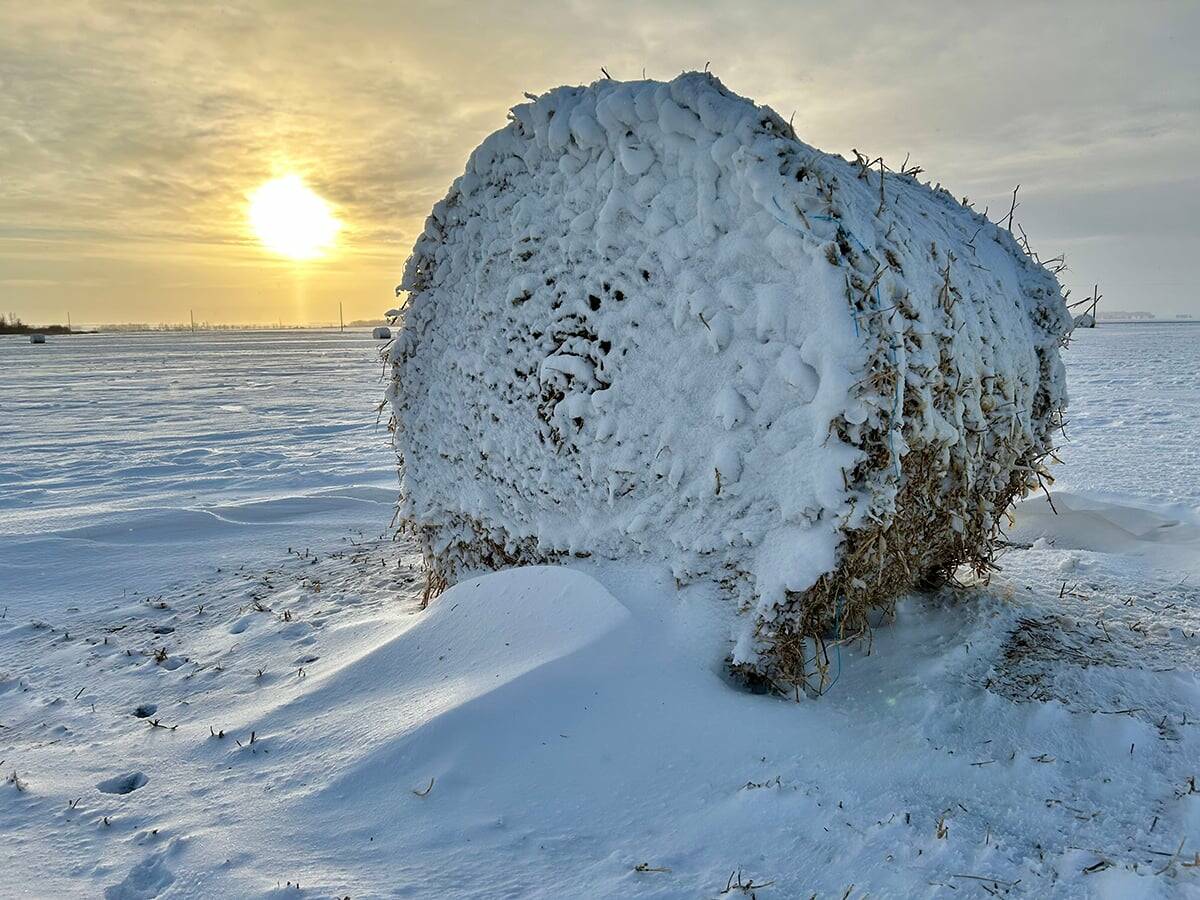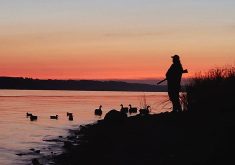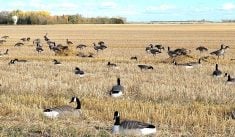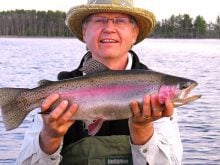Awhile back I asked our outdoorsy family friend, Terri, if she wanted to come ice fishing.
She deferred, saying, “I like fishing. It’s the ‘ice’ part that I don’t like.”
Like Terri, I think there is some mild insanity on display in the growing interest in the ‘hardwater’ fishing season, which really took off during COVID times when folks were looking for ways to get out of the house. I don’t do that well in the cold anymore, but I have an embarrassingly large inventory of ice fishing stuff and get out at least a dozen times each winter. It just doesn’t make any sense.
Read Also

What is perfect Christmas weather?
What is ‘perfect’ Christmas weather on the Prairies? Here’s where you should head this holiday, according to historical weather data.
Anglers and hunters are a pretty optimistic bunch, but ice fishing can really test our limits. When I’m on Lake Winnipeg, the world’s 11th largest lake, I’m fishing through an eight-inch hole. In open water, you might be trolling or casting a line – covering a bit of water, as we say. In the winter, unless you want to spend the day drilling holes in the ice, you’re pretty much frozen to one teeny-tiny spot. Looked at that way, the odds of fish in the frying pan don’t sound too good.
Kidding aside, before I recommend ice fishing to anyone, I want them to see it as an inherently risky activity. Of all my outdoor activities it has by far the largest menu of risks that can lead to trouble. Ice conditions and winter weather are not always easy to read and, if you get it wrong, it’s a dire situation.
For that reason, I’m going to focus more on staying safe and less on how to catch fish.
Survival skill
Historically, ice fishing was important to indigenous groups, particularly in the North. Accounts by many European explorers and anthropologists speak to people relying on fish caught through the ice.
One of my favourite reads is the journal of Samuel Hearne. In the 1770s, Hearne walked thousands of miles from Hudson Bay to the Arctic Ocean under the guidance and tutelage of Dene families. When they could not kill caribou in the winter, they camped by frozen lakes and out came the chisels, fishing lines made of sinew and hooks made from bone or ivory.
Two centuries later, I had an opportunity to work on an arctic char study along the Arctic Ocean and I was able to watch our Inuit neighbours ice fishing for char. It was early June, but they were sitting on seven-foot-thick ice, patiently jigging lures for char that were darting around in a large opening below.
Doris, the family matriarch, eventually caught a couple, but Peter, her husband, was skunked and frustrated. After an hour of this nonsense, he picked up his traditional fish spear, made from wood and musk-ox horn, and quickly had half a dozen on the ice. He also had a bit of a “so there!” look on his face. All I could think of was, “Man, I need to get me one of those!”
Like many others, I have geared up over the last few years to make it easier to tackle the elements head-on. Well, more like wall myself off from the cold as much as possible as I pray for something to come up the eight-inch hole. I have my power auger, ice-fishing rigs, too many lures, a portable tent, portable heater, portable chair, and a bunch other portable stuff that, when piled high on my sled, isn’t a very portable load to haul across the ice.
I don’t own a snowmobile, quad or 4 x 4 truck, so I often walk and haul my portable stuff on an overloaded sled. Much of my ice fishing has been on Lake Winnipeg, which attracts throngs of ice fishers from across Manitoba and even the U.S., where the snowdrifts get pretty hard and a reasonably fit person can log a mile or so in each direction and have a decent chance of getting some fish.
My friend Don and I did this for years and we almost always came back with something for dinner, and a good workout to boot.
It’s just fine when things go well, but I have had more adventures ice fishing than with any other outdoor activity. For the record, I define adventure as situations where the unexpected happens, and it’s generally for the worse.

Snow and ice
In my early 20s, I had a unique opportunity to be mentored by trappers and commercial fishers in northern Manitoba. They were always adapting to snow, ice and winter weather because getting it right is an occupational hazard and a life-saving necessity. I learned that ice conditions are fraught with uncertainty. Anyone who tells you otherwise should not be trusted.
Close to lakeshores or along rivers and creeks, seepage from springs or runoff during a warm spell can result in thin ice. Around an active beaver lodge, ice is always thin close to dams, feed piles and bank holes where beavers go to feed in winter.
On the main lake, especially on larger lakes, cracks can develop into pressure ridges where ice piles can be many feet high, but there is weaker ice right beside them. Stories abound about vehicles traveling safely for miles over three feet of ice, but breaking through and sinking to the bottom at a pressure ridge. Rivers have their own dangers, especially where shallow water or reefs make for faster currents and thinner ice.
Slush, unfrozen water that saturates snow above the ice, is especially vexing, and not just to snow machines. Getting caught in slush generally means, at a minimum, wet feet. Unfortunately, you often don’t spot an area of slush until you are already in it because the water layer is well below the snow surface. Slush is more common in years of deep snow, and it tends to happen closer to shore, where snow is deepest.
Avoiding shore areas is a good plan, but know that slush can also form around cracks and pressure ridges. It’s a good idea to ask beforehand if slush is an issue on any lake you want to traverse and stick to established trails where possible.
I got caught in unusual slush conditions on the Winnipeg River last winter. Along with deep snow, higher flows had occurred in March because of water releases from an upstream dam. In this case the areas with slush had refrozen on the surface during a cold spell, so it looked just like normal ice. My wife and I were following a track made by a snow machine only 30 minutes earlier. It turns out that the ice held the machine, but not us. We broke through that crust and were standing almost shin-deep in ice water lying atop the main lake ice.
We were lucky because the temperatures were at the freezing point. At -20 C, we might have gotten frozen feet before making it back to shore. I thought I had taken all the right precautions but, as it turned out, “Mr. Experienced Guy” got it wrong.
Watch out for wind
Stories abound about folks going out in windy or even blizzard conditions. On our bigger lakes, expect wind speeds to be at least 10 km/h stronger than on land, and it doesn’t take much to get snow blowing. Of course, I know better – except for the times that I didn’t, and I got caught in touch-and-go situations.
A few years back, my buddy Pat and I decided to hit Lake Winnipeg. There was some wind in the forecast, but we thought it manageable. Sure enough, at dawn we drove out in his 4 x 4 truck, easily following a track to a spot that had produced well a few days earlier. We also had a tent, heater and GPS.
The spot was as advertised. We caught our limits and released some large walleye, but the modest winds of the morning had picked up through the day, the temperature plummeted, and ground drift started. When we stuck our heads out of the tent in late afternoon, we knew we had left it too long.
We got out without mishap, but only because the sky was clear and we were able to follow our track back to shore. Here were two guys with more than six decades of experience combined, and we let fishing fun trump the weather realities.
Access to reliable weather information is crucial. I use SpotWx, which has forecasts of temperature, wind, precipitation and barometric pressure from Environment Canada and U.S. weather models. It provides localized forecasts wherever you drop a pin on their map. It’s a great tool to help decide whether to fish or go back to bed. When you are on the ice, be prepared to pack up and leave if the wind picks up, even if the fish are biting.
Another good habit is to bring enough extra clothing to survive a night on the ice. I also bring extra socks in case I get wet feet. If you don’t have a tent or shack, bring a tarp, which can function as a windbreak if you need it.
Still want to give it a try?
The best advice for newbies is to talk nicely to an ice-fisher you trust, and hope they take you out once or twice. Local wildlife associations often put on family-focused ice fishing events, complete with volunteers ready to help. You can use these experiences to test-drive this recreation before you invest in equipment. When you start out on your own, stick to smaller lakes, where you can easily walk to a fishing spot, or well-used areas where help is nearby.

Equipment galore
There is no limit to ways you can spend money on ice fishing gear. As measured by the standards of the day, my fairly basic kit includes a tent, portable propane heater, ice auger, sled, tackle and a lower-end fish locator. It adds up to just north of $2,000 these days.
As to the end of your line, almost every fish that swims can be caught on a jig and a salted minnow. Smaller species, like perch, can be had with a small jig and half a minnow. Add a few spoons of various sizes and you’re covered. Most of us eventually get seduced by the latest-and-greatest lures, and the tackle box bulges far more than necessary.
Many people use portable sonar units, often called flashers. Marks on the screen help you detect fish and how they are reacting to your lure. I have one and I think I catch more fish with it. That said, my friend Pat, who usually catches more than anyone, doesn’t own a flasher, saving himself about $500, not to mention bragging rights. In the end, I’m not sure if my unit did a better job of catching the fisherman than it does the fish.
My brother, Robert, uses an underwater camera on the small, gin-clear lakes he fishes near Riding Mountain. Watching fish react to your bait is a whole lot of fun. Not long ago, a 15-pound pike moved in on the camera – think Jaws, but with smaller teeth and no music – and it struck. It was all over in an instant, and the beast slowly swam off. It gave me a sense of the petrifying last moments of unlucky minnows. (A brief video of the encounter is up online.)
A day on the ice with family or friends can be lots of fun and you may have the bonus of fresh fish for the table. That said, never take your eye off the risks and keep your wits about you. Good luck!
















